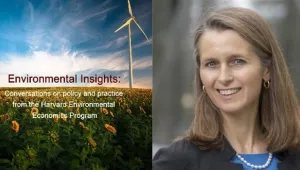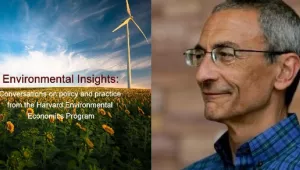In this interview, edited for length and clarity, Harvard Project Director Robert Stavins talked to Argus about the state of U.S. energy and climate policy and the prospects for action on energy legislation.
Argus: How would you describe current US climate policy?
Stavins: Climate policy is currently in suspended animation in the United States. I say that because on the one hand, a meaningful national carbon-pricing scheme, which is probably what is most needed in the US to achieve significant goals, is obviously on hold until there are political changes.
The Senate made it clear that it was not going to pass something like the Waxman-Markey bill and now — given the changes that have taken place in the House of Representatives since the November mid-term elections — the Waxman-Markey legislation itself could not pass. So there is not likely to be carbon-pricing legislation before 2013, after the next presidential election, at the very earliest, and even for that a whole set of political cards would need to fall into place.
However, having said that, climate policy is definitely moving forward on other fronts. The first is on the regulatory front being exercised by the Environmental Protection Agency (EPA) through the Clean Air Act. This results from the Supreme Court decision that the EPA has the power to regulate greenhouse gases (GHGs). On this front the EPA is moving to regulate CO2 emissions from passenger vehicles, light trucks and ultimately stationary sources, including utilities. The EPA is also moving forward with new regulations on SO2, NOX, particulates, fly ash and cooling water for power plants. Those could have even more important impacts on the investment and the dispatch of coal-fired power plants — and hence on CO2 emissions — than direct GHG regulation.
The EPA's role is being challenged. There may be a successful move in the Senate through senator Jay Rockefeller's (D-West Virginia) legislation to delay EPA oversight of GHGs for 2 years. There could even be a successful push to prevent any EPA regulatory action over GHGs at all. However, it is reasonable to assume that President Barack Obama would refuse to sign off on such moves and so the EPA's regulatory front will continue to advance.
Secondly, there is regional and state-level climate policy action relating to the Regional Greenhouse Gas Initiative (RGGI) of 10 northeastern and mid-Atlantic states. And California is progressing with its climate law, which will put in place a cap-and-trade system as part of a mix of policies to reduce emissions.
Argus: President Obama has proposed an 80pc clean energy standard (CES) by 2035. How significant would this be?
Stavins: The first thing is to question how valuable it is. A national renewable electricity standard (RES) would mandate that a given share of an electric company's production comes from renewable sources or, in the case of a clean energy standard, from an expanded list including nuclear and hydroelectric power. If the clean energy standard applies only to the electricity generation sector, then, although it can be significant, it is going to be a lot less significant than the 83pc GHG reduction by 2050 proposed under the Waxman-Markey legislation, which was across all sectors of the economy.
Argus: How should such a CES be structured?
Stavins: If the purpose of it is to address climate change, then it should be done in such a way that proper incentives are put in place proportional to the carbon content of the various means of generating electricity. By that I mean you need to be providing short-term incentives for natural gas relative to coal (both in terms of investment in new facilities as well as utilization of existing facilities); you have to be providing the right incentives for nuclear; you have to be providing incentives for carbon capture and storage; and you have to be providing incentives that reward hydro. For zero-CO2 producing technologies (like renewables and nuclear) the incentives should essentially be the same.
In other words, the credits a utility earns for a given source of generated electricity should be inversely proportional to the CO2 emissions associated with that source. Renewables and nuclear would earn full credit whereas natural gas and fuel oil sources would earn less, and conventional coal less than that. If properly structured, this can provide the right incentives for investment and retirement of electricity-generating capacity and the right incentives for dispatch from existing capacity.
The renewable energy standard approach typically involves nationwide trading between utilities of renewable energy credits. The clean energy standard approach should do likewise.
By making incentives proportional to the CO2 output of each fuel and making credits tradable nationally, you have effectively created a CO2 cap-and-trade system that is called something else. If that is what it takes to make it politically feasible then that is fine, but the incredible irony is that the most cost-effective way to do it for the economy is with a carbon-pricing scheme, such as cap-and-trade. The further you are away from cap-and-trade, the less effective and the more costly the scheme is going to be.
Argus: What are the drawbacks of using a CES as opposed to a cap-and-trade system?
Stavins: The major disadvantage of using a clean energy standard instead of the sort of cap-and-trade system considered last year by the Congress is that the CES applies only to the electricity-generation sector, which accounts for not much more than a third of US CO2 emissions.
Argus: The Obama administration has linked the development of clean energy technologies in the US to more local jobs? How realistic is this?
Stavins: One has to be very careful. As soon as we use the word 'jobs' we are essentially in the political world rather than the world of economic analysis. There is a lot more heat than light in this area of green jobs.
The fact that we put in domestic regulation to increase the demand for carbon-friendly products may be meritorious on its own, but it does not mean that those products are going to be manufactured in the United States. We have had very strong motor vehicle fuel efficiency standards for some time, but it has been Japanese and Korean companies with their comparative advantages in the manufacture of such automobiles, who have successfully sold them in the US market. It has not been Detroit that has benefited.
We have policies that lead to high demand for wind energy in states like Texas and California but companies are going to rightfully purchase the lowest cost turbine, regardless of where it is manufactured.
So we sometimes mislead ourselves that because we put in place policies that will create the demand for a particular technology, that therefore those technologies will be manufactured here.
Argus: You argue that a better way to foster green jobs is to focus on the long-term determinants of economic growth — like innovation. Are there ways the government can encourage greater business investment in new climate-friendly innovation?
Stavins: One important market failure affecting the clean energy economy is the failure of private firms to invest in invention and innovation. When the private sector carries out basic climatefriendly R&D, they pay all the cost of the R&D but they do not get all the benefits, because even under a perfect system of intellectual property rights, information itself is really in the public domain — it is what economists call a "public good." Patents have a finite life and even long before patents expire there is information spillover, which other companies and countries take advantage of. As a result, firms will carry out less than the efficient amount of R&D.
Therefore, economically there is a justification for policies focused specifically on basic R&D, promoting the invention of new technologies and the commercialization of new innovations. There is an argument for government subsidies for the invention of new and better carbon, capture and storage technologies or more fuel-efficient motor vehicle technologies. However this is not an argument for subsidies for adopting existing technologies.
The huge problem with this, of course, is that government is funding private sector-executed R&D for the technologies of the future, but does not know ahead of time what those technologies will be. The vast majority of attempts are going to be dead ends. It puts government in the role of picking winners and losers and the US government does not have a very successful track record in doing that. It is fundamentally hard to do — no one can know in advance what will work — so you have to fund quite broadly, knowing that many avenues will not pay off. One way of doing this economically is by offering prizes to the most energy efficient technology in a specific sector, for example, so the subsidy goes to the most successful innovation, not to everybody. In a difficult economic climate, this is much more efficient than giving blanket subsidies.
Argus: Are the EPA's efforts to regulate GHGs an effective alternative to a national carbon-pricing scheme of some sort?
Stavins: The EPA's regulations will be relatively costly for what they accomplish and they are not going to be able to be economywide since they apply to targeted sectors. Whereas they may be helpful for 2020 targets, they will be grossly insufficient for ambitious 2050 targets.
Argus: To what extent can state actions to reduce climate change through state-based CES, GHG gas reduction targets and regional cap-and-trade programs, substitute for national actions?
Stavins: The West coast, the Northeast and a few of the Midwest states are the areas most likely to be progressing in terms of state-based efforts to reduce greenhouse gas emissions. It does not cover the entire US but in terms of CO2 emissions you are covering a surprisingly large share of it. However the smaller the jurisdiction, the greater the degree of leakage in terms of displaced economic activity as firms relocate to other states with less stringent CO2 regulations. The leakage from the RGGI was estimated to be as much as 50pc — mainly from New York to Pennsylvania. California will have significant leakage associated with implementing its climate laws, which include a cap-and-trade scheme starting in 2012. The more states you have involved, the less leakage there is. The right way to do it is with a federal policy. However in the absence of a federal policy, California teamed with RGGI and some Midwest states and Canadian provinces, could evolve into a North American climate policy initiative, if they were to all link their various systems together. It is conceivable we will see that sort of linkage before we see a national policy.
This interview is reproduced with permission from Argus US Carbon.
Stavins, Robert N. “Argus Q&A: Robert Stavins.” Argus US Carbon, February 14, 2011





